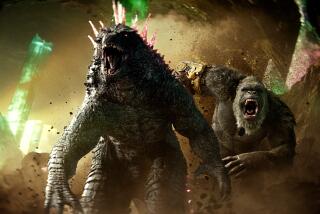How ‘Sonic the Hedgehog’ director saved the movie from massive internet backlash
After Paramount Pictures released the first trailer for its “Sonic the Hedgehog” movie last April, the film seemed doomed to an increasingly common fate in Hollywood — death by internet backlash.
Footage from the live-action/computer-animation hybrid, based on Sega’s flagship video game franchise, drew fury from fans who described the famed blue speed demon’s design as “nightmare fuel,” with many citing his unnervingly humanoid teeth.
For Jeff Fowler, the first-time feature director tasked with bringing Sonic to life, the rebuke stung. But the 41-year-old visual effects veteran quickly rallied his team in Culver City to take the unusual step of redesigning the character to more closely resemble the hedgehog first introduced in 1991.

“I allowed myself an hour or two where I was feeling pretty sorry for myself,” Fowler told The Times. “But then it was like, ‘You know what? You’ve got to get everybody excited about doing the revision, as crazy as that sounds.’ There was definitely a bit of a pep talk, but it was all genuine because I really believed it was a problem that could be solved.”
Social media can be unforgiving for studios trying to bring nostalgic intellectual properties to the big screen. In a business dominated by titles based on already beloved characters and stories, studios must often grapple with how much to cater to any given franchise’s most vocal fan base.
Universal Pictures’ “Cats,” based on the Andrew Lloyd Webber musical, never recovered from its first trailer, which was widely jeered for its jarring digital effects that turned its actors into CGI human-feline hybrids. After months of serving as the butt of online gags, the film flopped at the box office. On the other hand, Walt Disney Studios refused to cave to online snark directed at Will Smith’s blue-skinned genie in the initial marketing for last year’s “Aladdin” remake. That movie grossed more than $1 billion.
Reshoots have become commonplace on big-budget studio movies, but rarely are they done in response to such a public outcry over marketing materials. For Fowler and ViacomCBS-owned Paramount, however, it was obvious “Sonic” needed a makeover. Fowler tweeted several days after the backlash, promising changes were coming. After that, Paramount and Sega kicked in an estimated $5 million for the revisions, and delayed the release by about three months so fixes could be made.
The problem with the first design was “too much realism,” Fowler said. On the next attempt, the filmmakers embraced the “cartooniness” of the character, making the eyes bigger and the teeth less visible.
“It’s a ‘Sonic the Hedgehog’ movie, and the fans who’ve been loving this character for 30 years are the ones we needed in our corner,” Fowler said. “It was definitely a challenge but a very exciting one, once it all clicked.”
If the PG-rated movie succeeds when it’s released this weekend, it could generate a much-needed new family-friendly franchise for Paramount, which is looking to recover from years of box-office struggles.
For Tokyo-based Sega Sammy Holdings, a winning adaptation would breathe new life into an aging video game series by expanding it to new audiences, much in the same way mobile game maker Rovio and Sony Pictures did with the “Angry Birds” movies.
“We wanted to create an experience that would allow for the younger generation to experience what their parents had experienced almost 30 years ago,” said Los Angeles-based Sega executive Toru Nakahara, who represented the company as a producer on “Sonic the Hedgehog.”
“Sonic the Hedgehog,” co-produced and co-financed by Paramount and Sega, is expected to gross $40 million to $45 million through Monday. That would represent a solid four-day performance for a production that cost $87.5 million, split between Paramount and Sega, including added expenses to redo the title character. Much of the animation compositing work was done by Technicolor’s MPC office in Vancouver, which closed in December, citing “external market pressures in Vancouver and more attractive opportunities in other locations.”
In the film, Sonic is portrayed as an alien creature (voiced by Ben Schwartz) who befriends a small-town cop (James Marsden) and must evade the mad genius Dr. Robotnik, played by a mustache-twirling Jim Carrey.
Sega has been trying to bring the lightning-quick hero to the big screen for years. Sonic games have shipped 920 million copies since the early 1990s, when Sega was still considered the chief rival of Nintendo.
Sega struggled to compete with Nintendo and Sony’s Corp.’s PlayStation, and stopped making its own consoles in 2001 following poor sales of its Dreamcast. Sega has continued to produce Sonic games as a third party publisher. The character has also appeared in animated TV shows, comic books and even an insurance commercial over the years, but has never anchored a theatrical film.
Video game adaptations are notoriously risky at the box office, with flops including the most recent “Tomb Raider,” “Assassin’s Creed” and “Warcraft,” though last year’s “Pokemon: Detective Pikachu” performed solidly for Legendary Pictures and Warner Bros. A big-screen version of Nintendo’s flagship franchise “Super Mario Bros.” was a massive flop in 1993, and continues to serve as a cautionary tale for studios.
“If ‘Sonic’ works, it looks like Sega at least beat Nintendo to the punch in terms of having a successful movie,” said Jeff Bock, a box-office analyst at Exhibitor Relations.
The movie was originally set up at Sony Pictures with producer Neal Moritz, known for the “Fast & Furious” franchise, who began developing the project in 2014. Tim Miller, director of the hit Marvel comedy “Deadpool,” later joined as executive producer.
To direct, the producers in 2016 recruited Fowler, a veteran of Miller’s company Blur Studio. Fowler, who was 13 when the first Sonic game came out, had joined Blur as a character animator in 2003, and shortly after directed the Oscar-nominated animated short “Gopher Broke,” based on an idea he submitted for a contest at Blur.
Since then, he worked on commercials and did visual effects for movies such as Spike Jonze’s “Where the Wild Things Are,” but had yet to helm a feature-length movie.
The project languished in development at Sony, and Moritz took it to Paramount in late 2017 after he signed a broader production deal with the Los Angeles-based studio. Paramount, under the new leadership of Jim Gianopulos, was hungry for potential franchises.
One key step was figuring how to portray the hedgehog’s personality, a common problem with video game characters making the jump to Hollywood. Fowler and the writers found inspiration in the early games, which presented Sonic as a youthful smart-aleck, despite a lack of dialog. In the game, if the player stopped pushing buttons, Sonic would impatiently tap his feet or stare at his wrist. That, plus the later TV shows and comic books, gave the filmmakers a foundation to work from.
“Most of those times, a video game character is just there to go left or go right or to jump,” Fowler said. “Even in the simple 16-bit introduction to the character in 1991, there was still some real attitude that came through. It felt very teenager-like and relatable.”
More to Read
Inside the business of entertainment
The Wide Shot brings you news, analysis and insights on everything from streaming wars to production — and what it all means for the future.
You may occasionally receive promotional content from the Los Angeles Times.







